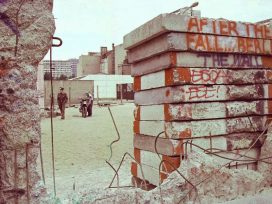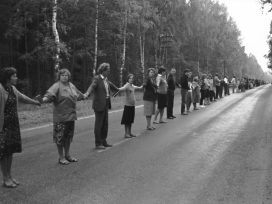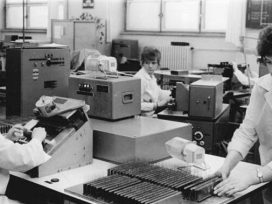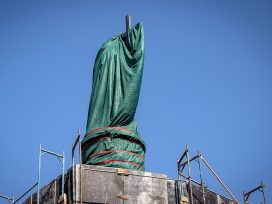András Schweitzer: Western leaders were more than reluctant to support the historic events of 1989. Apparently, they did not want to leave behind the bipolar world order, which they found stable and predictable – this is what Hungarian historian László Borhi has claimed.The Year 1989. A conference jointly organised by the Institute of History of the Hungarian Academy of Sciences, the Working Group for the History of Europe of the Social Science Centre of HAS, the Európa Institute in Budapest, and the monthly História, 20 October 2009, Budapest. Do you agree with his statements?
Mark Kramer: I don’t fully agree with László, although I agree with him up to a point. It is not really accurate to say that Western governments wanted to keep the status quo indefinitely. I would distinguish the short term from the longer term. Even though large bureaucracies normally prefer to stick with the procedures and situations they are familiar with, that was not the main constraint on Western policy in 1989. Western leaders never accepted the permanent existence of Communist dictatorships in Eastern Europe, they very much welcomed the changes that were going on in the late 1980s, but they also wanted to ensure that the process of change would be orderly and would not veer out of control, perhaps leading to chaotic violence. It’s easy nowadays, with the benefit of hindsight, to argue that Western governments were too timid and too modest in their goals. But many people at the time were worried about the limits of Moscow’s tolerance and the prospect of a violent crackdown if events proceeded too fast and too far. These concerns were perfectly understandable, even if ultimately unfounded. There was a lot of uncertainty at the time – it is reflected not only in public comments in the West, but also if you look at the declassified transcripts of conversations that various officials in Poland and Hungary were having among themselves. Given the record of 1953, 1956, 1968, and 1981, no one until 1989 could be fully certain that the Soviet Union would not put pressure to move things back. Some concern still existed in Hungary as late as July 1989, even after the reburial of Imre Nagy in mid-June.
AS: What were your expectations back then?
MK: By early 1989, after Imre Pozsgay’s characterization of the Hungarian Revolution as a “popular uprising against a dictatorship that was humiliating the nation” failed to elicit any reprisal from Moscow, and especially after the June elections in Poland I regarded the Brezhnev Doctrine as dead. And I am not saying this just in retrospect. I wrote an article that appeared in the American journal International Security in the late summer of 1989. I had written it back in April. Its title was “Beyond the Brezhnev Doctrine” because basically the argument was that Gorbachev had done away with the Brezhnev Doctrine. I remember I laid out a few scenarios, one of them was that the whole bloc would collapse: communism would come to an end and the Warsaw Pact would dissolve. But I did not yet regard that as likely. Another scenario was along the lines of what Gorbachev was seeking, the continued existence of the Warsaw Pact with reformist governments. But the problem with that was that there were still four governments out of the six that weren’t moving in a reformist direction at all. Another scenario that I laid out was that the Soviet military would seek to move against Gorbachev. The fourth scenario was that Gorbachev would decide that his policies had gone too far and would send military forces into Eastern Europe. I regarded that as very unlikely. When that article came out, I was criticised by many readers as being too naïve or too bold. They expected Gorbachev to clamp down. Within a few months it turned out that I was not bold enough.
AS: At the conference you claimed that even a year before those events, there was no one who would have forecast them, because they were far from being inevitable. So how did you view the situation somewhat earlier, say in the symbolic year of 1984?
MK: Back then, as a first-year graduate student, I thought it was inconceivable that communism would disintegrate in Eastern Europe. I was in Hungary at that time and even though Hungary was not as unpleasant as, say, Czechoslovakia or Romania or East Germany, all of which I visited in that same trip, it was still a Communist country that I found quite oppressive to be in. It wasn’t anything like Romania though. In Romania I was followed even though I was just a young graduate student, only twenty one years old. And they obviously wanted me to know I was being followed. In the case of East Germany, I later found out from my Stasi file that the desk clerk there was reporting on when I left and when I came back to the hotel and what I said. By the way, although the desk clerk reported quite accurately, the file wasn’t all that interesting, but what he did report was true. I remember I had made one comment on the phone at a certain point, I said something like: I don’t know how anyone can live in this stupid police state. And he reported it word for word quite accurately. But to answer your question, I know no one who in the mid- 1980s was predicting that by 1989 communism would disintegrate. No one.
AS: Were there any predictions at any point in time that came somewhat close to what finally happened?
MK: A Russian dissident Andrei Amalrik wrote an essay in 1970 with the title “Will the Soviet Union Survive Until 1984?” and in it he said the Soviet Union would be gone by that time. But the reasons he gave were wrong. He thought there was going to be a war with China. Adam Ulam, a Polish émigré, a former colleague of mine at Harvard, at the height of the oppressive Brezhnev era in 1975 was speculating that if a truly reformist leader who wanted entirely to do away with the Stalinist legacy somehow came to power in Moscow ten years later – as it coincidently happened exactly in 1985 – such a leader would be unable to deny the same liberalisation to Eastern European countries if they wanted it. So Adam, who died in 2000, was one of the very few people who basically got the dynamic correct. But he readily acknowledged that he didn’t think it would actually ever happen. He didn’t think any such Soviet leader would ever really come to power.
AS: Retrospectively, where do you see the turning point from where the dissolution of the Soviet bloc could have been foreseen?
MK: The real turning point came in mid-1988, because it was that time that Gorbachev had to make choices about which way he was going. He was given advice by his military officers – by Marshal Sergei Akhromeyev, who was then chief of the Soviet general staff and subsequently became Gorbachev’s personal military adviser, and by others – and they were telling him that things were going too fast, and that he had to slow things down and not endanger the Warsaw Pact, which they were claiming he was doing. He went against their advice. To do that – and I am talking about this retrospectively, I didn’t know at that time that he was going against his advisers – signalled a real commitment to carrying out genuine changes instead of just cosmetic changes that, say, Brezhnev had made. When Brezhnev announced changes they were usually phony. Similarly, in terms of Soviet domestic policy, the XIXth Party Congress of the Soviet Communist Party was held in July 1988, and that’s when they decided to dismantle the central party apparatus and to hold competitive elections starting in 1989. Both things were extremely important in pushing things ahead. But even then it remained to be seen what Gorbachev would decide if push came to shove in Eastern Europe. And the test came in East Germany in October 1989. Erich Honecker, the hardline East German leader, was convinced until the end that the Soviet Union would come and bail him out. In the wake of the Tiananmen Square massacre in China in June 1989, Stasi boss Erich Mielke and Honecker were talking enthusiastically about implementing a “Chinese solution” in East Germany.
AS: Were there such hardliners in the Soviet Union too?
MK: They did not want to let it go as far as it had gone in China, to allow that scale of demonstrations. There were hugely damaging strikes by coal miners in the Soviet Union in 1989 and there were people at the KGB who argued that they had to clamp down right away because otherwise the situation was going to approach something like the Tiananmen Square protests. Committing mass bloodshed was something most of those high up were reluctant to do. Even in East Germany they wanted to clamp down before it got to that stage. When mass demonstrations did break out in October in East Germany there were calls within the KGB to try to rein in the situation. But there is no indication that in the Soviet Politburo anyone was recommending the direct use of Soviet military force – including Vladimir Kryuchkov who was the head of the KGB. Eduard Shevarnadze who was then foreign minister has claimed that there were people, like Defense Minister Dmitrii Yazov and others, who did recommend that, but the evidence doesn’t bear that out. Nor does the evidence really show that even Dmitrii Yazov was arguing in favour of a forceful clampdown in East Germany, even though he was horrified by what was going on. There were military commanders in the Soviet Army who would have favoured a crackdown, but they were not the ones who could have made the decision to use force. Some of them though said openly after the Soviet Union broke apart that there should have been a forceful reaction in East Germany.
AS: At the Budapest conference there were participants who suggested that it would have been too much for the Soviet Union to crack down in so many countries in Eastern Europe at once.
MK: They wouldn’t have had to face that choice. The Polish leader Wojciech Jaruzelski would have used force if he had been given the green light by Moscow. It has been disclosed that there was planning by the Polish Ministry of Internal Affairs to impose martial law after the elections, but nothing came of that because Moscow refused to back it. In Hungary, after Imre Pozsgay had made his statement in January 1989 about the Hungarian Revolution, it could have sparked a severe protest from Moscow both publicly and privately and military exercises held in Hungarian territory by the Southern Group of Forces might have been just such a protest, albeit in veiled form. A slightly more open demonstration of anger, or dissatisfaction, that type of thing would have been enough. But instead of voicing a protest, one of Gorbachev’s closest aides on the Politburo, Alexander Yakovlev, made a statement that it was entirely for the Hungarians themselves to judge.
AS: What would have happened if the Soviet Union had decided, say in the summer of 1989, that it was time to reassert a more orthodox system?
MK: It probably could have been done without resorting to violence. Unlike the situation that developed in the GDR by October 1989 and in Czechoslovakia by November 1989, with mass demonstrations against the hardline regimes occurring every night, the changes in Hungary had been proceeding in a relatively orderly fashion. The faction of the Communist Party affiliated with Miklós Németh and Imre Pozsgay were much bolder than the faction affiliated with Károly Grósz, but even Grósz was willing to put up with significant change. So, most likely, the Soviet Union would have backed Grósz against Pozsgay and Németh and ordered him to put an end to the Round Table Negotiations. Most of the reforms could have been kept in place for the time being, but eventually the Soviet Union would have pushed for Grósz’s removal and the gradual reversal of the reforms. This might have been feasible up until September-October 1989. All that said, I find no evidence that any major leader in the Hungarian Socialist Workers’ Party was making contingency plans for this scenario. Even though, as late as July 1989, they were worried about Soviet reactions, they did not seem to have a plan for what they would do if the Soviet Union did clamp down.
AS: How come the Soviet Union didn’t even try to intimidate those who wanted change in Eastern Europe?
MK: For the reasons that Adam Ulam mentioned, Gorbachev found that his domestic objectives, seeking to eliminate all remnants of Stalinism, would elude him so long as he tried to maintain an orthodox Communist bloc in Eastern Europe. He also thought that by liberalising the Soviet political system he would be able to win public support for a bold economic-reform programme. His objective from the beginning was to revive the Soviet economy and to restore it to fast growth, for example, by giving individuals and factories greater control over how they handled their own affairs. Of course he did not succeed, he ended up with something that was neither a market nor a centrally planned economy. He created an incoherent mix of the two. When he came to power, the Soviet economy was slowing, but as a centrally- planned economy it essentially functioned. By 1990 the Soviet economy was in a real crisis as a direct result of Gorbachev’s confused and destabilizing policies.
AS: Did the whole chain of events happen solely because of Gorbachev? In this part of Europe people like to believe that they played an important part, on the other hand, of course, we are aware that it is not the tail that wags the dog.
MK: It was a prerequisite that Gorbachev was determined not to use military force in Eastern Europe. Once that became clear to people, as it certainly did by October 1989, they went out onto the streets in vast numbers and pushed for the removal of the regimes they had lived under. In earlier decades (in 1953, in 1956, in 1968, in 1981) the Soviet Union was willing to use military force to keep things under control. If Soviet policy hadn’t changed, no matter how many people in Eastern Europe had wanted change, they wouldn’t have been able to make it, because Soviet troops would have intervened. So the drastic change in Soviet policy was a necessary condition, but it wasn’t a sufficient condition. The sufficient condition was the combination of the change in Soviet policy and the willingness of millions of East European people to take that opportunity into their own hands and push for radical change before it could be stopped.
The East German authorities weren’t about to move in a Gorbachev-like direction, they wanted to maintain an orthodox repressive Communist system. So it took those hundreds of thousands and millions of people to go out to the streets to force the East German regime to back down. The East German regime would have clamped down at an early stage if they had received Soviet backing. But Gorbachev denied that backing. By that time in Hungary and Poland events had already proceeded very far. In Poland, millions of people had voted for Solidarity at the elections, they obviously felt no fear about doing so. In Hungary three hundred thousand people attended the reburial of Imre Nagy, which until 1988 would have been impossible because János Kádár would have never put up with that. Prague is a city of just over a million people, but at the height of the Velvet Revolution more than a million people were out on the streets of Prague, which meant that people had also come from nearby. The Czechoslovak regime, when faced with demonstrations like that, wasn’t going to survive very long. They used violence on 17 November but – contrary to what happened in China, where large-scale coercive violence proved to be very effective – they used it on a very limited scale, which could only have a counterproductive effect: it made people angrier and spurred them to come out on the streets in defiance in ever greater numbers.
People’s sense of fear was disappearing everywhere in the region. I can give you a personal example. My father’s family, twenty seven Latvian Jews, were deported to the Gulag by the Soviet NKVD on 13-14 June 1941; there were only three who made it back after being imprisoned in the Gulag for sixteen years. As a result, the three who came back tended to be very timid and unwilling to engage in any public protest, because they knew the consequences could be very severe. In the spring of 1988 I found out that two of my cousins had joined the Latvian Popular Front, which at that time was supportive of Gorbachev’s liberalization, but it was the type of organization that would have been impossible to form in the past. It would have carried enormous risks if you had tried to do this. So at that point I realized that something was changing in the Soviet Union. Because if my cousins felt they could do that, it must mean that people weren’t held back by fear any more from engaging in non-official politics.
AS: With the archives still opening up in Eastern Europe, have there been any new surprises for you lately about the events of the Cold War?
MK: For example the fact that on the 30 October in 1956, the Soviet Presidium, as the Politburo was called at that time, made the decision to pull Soviet troops out of Hungary, and to let the Revolution proceed. That decision was reversed the next day and two hundred thousand Soviet troops moved in. One of the things that brought this about was the Republic Square incident on the thirtieth, when state security officials were lynched and severely beaten. That was mistakenly assumed to be the start of a larger wave of violent reprisals, whereas in fact we know now that that incident caused a backlash in Hungary, and if anything, behaviour tended to calm down. Another important factor for the decision was the spillover effect from Hungary to Romania and to Czechoslovakia and especially to Western Ukraine. In Transylvania, there were large demonstrations, the Romanian authorities were alarmed, the Romanian Politburo was meeting daily to discuss what to do. That’s why Romania volunteered to join the Soviet Union in invading Hungary. Khrushchev turned down that offer. But I was amazed; in fact I was stunned to find out that even for a day the Soviet leadership had considered letting Hungary go. Now if you think about it, thirty-three years later it was exactly what Gorbachev did, basically to stand aside as things were falling apart in Eastern Europe. Many commentators described the Soviet invasion of 1956 as the “first nail in the coffin of the Soviet bloc” and the “first step in the collapse of Communism.” In reality, precisely the opposite is true. If Soviet leaders had not undertaken a full-scale invasion on the 4 November and had instead allowed the Communist system to collapse in Hungary and permitted Hungary to leave the Warsaw Pact, the consequences would have been enormous. The events of 1989 showed that the collapse of Communism in one Soviet-bloc country could rapidly spread to others. By resorting to a large-scale invasion in November 1956, Khrushchev preserved the Soviet bloc for a couple of decades.







